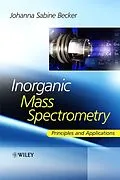Providing an exhaustive review of this topic, Inorganic Mass
Spectrometry: Principles and Applications provides details
on all aspects of inorganic mass spectrometry, from a historical
overview of the topic to the principles and functions of mass
separation and ion detection systems. Offering a comprehensive
treatment of inorganic mass spectrometry, topics covered include:
* Recent developments in instrumentation
* Developing analytical techniques for measurements of trace and
ultratrace impurities in different materials
This broad textbook in inorganic mass spectrometry, presents the
most important mass spectrometric techniques used in all fields of
analytical chemistry. By covering recent developments and advances
in all fields of inorganic mass spectrometry, this text provides
researchers and students with information to answer any questions
on this topic as well as providing the basic fundamentals for
understanding this potentially complex, but increasingly relevant
subject.
Autorentext
Johanna Sabine Becker; Since 1997- Deputy Head of Central Department for Analytical Chemistry, Research Centre Jülich.
Klappentext
In organic mass spectrometry provides established analytical techniques to analyze know and unknown materials in respect to their elemental composition or species, to quantify the elemental concentration of major, minor and trace elements in any samples for the determination of the exact mass of isotopes and precise and accurate isotopic abundances or isotope ratios. Beginning with a historical overview of mass spectrometry, Inorganic Mass Spectrometry: Principles and Applications presents the fundamentals and instrumentation of the most important inorganic mass spectrometric techniques, describes a wide range of analytical methods and a multitude of applications.
This comprehensive work provides an insight into the state of the art of mass spectrometry in different challenging areas and recent developments and presents representative coverage of many topics. It is concerned with the most important types of mass spectrometers and presents an overview of new methodological developments and trends for analytical work and modern applications especially in survey, trace, ultratrace, surface (micro- and nanolocal analysis, imaging and depth profiling) and isotope analysis.
The first part of the book descries fundamentals of inorganic mass spectrometry (basic principles and developments of ion sources, ion separation systems and ion detectors) and instrumental developments in ICP-MS, LA-ICP-MS, GDMS, SIMS, TIMS and other mass spectrometric techniques. The second part focuses on a multitude of quite different applications including:
- Materials science
- Environmental Science and environmental control
- Biology
- Bioengineering
- Medicine
- Food analysis
- Geology and geochemistry
- Cosmochemistry, planetary and space science
- Determination of long-lived radionuclides
- Forensic applications
- The study of cluster and polyatomic ion formation by mass spectrometry
Extensive appendices include a table of isotopic abundances, atomic mass and ionization energies of elements; a table of atomic weights of elements; and a list of standard reference materials for isotope ratio measurements.
Inorganic Mass Spectrometry, written by an author with extensive experience in research and teaching provides a balanced mixture of practice-oriented information and theoretical background that will prove useful to both new and established practitioners in this field.
Zusammenfassung
Providing an exhaustive review of this topic, Inorganic Mass Spectrometry: Principles and Applications provides details on all aspects of inorganic mass spectrometry, from a historical overview of the topic to the principles and functions of mass separation and ion detection systems. Offering a comprehensive treatment of inorganic mass spectrometry, topics covered include:
- Recent developments in instrumentation
- Developing analytical techniques for measurements of trace and ultratrace impurities in different materials
This broad textbook in inorganic mass spectrometry, presents the most important mass spectrometric techniques used in all fields of analytical chemistry. By covering recent developments and advances in all fields of inorganic mass spectrometry, this text provides researchers and students with information to answer any questions on this topic as well as providing the basic fundamentals for understanding this potentially complex, but increasingly relevant subject.
Inhalt
Foreword xiii
Preface xvii
Acknowledgements xix
Introduction to Mass Spectrometry 1
1 History of Mass Spectrometric Techniques 7
References 22
2 Ion Sources 25
2.1 Inductively Coupled Plasma Ion Source 28
2.1.1 Laser Ablation Coupled to an Inductively Coupled Plasma Ion Source 38
2.1.2 Electrothermal Vaporization Coupled to an Inductively Coupled Plasma Ion Source 43
2.1.3 Hydride Generation and Cold Vapour Technique Coupled to an Inductively Coupled Plasma Source 43
2.2 Spark Ion Source 44
2.3 Laser Ion Source 46
2.3.1 Laser Plasma Ionization 46
2.3.2 Resonant Laser Ionization 50
2.4 Glow Discharge Ion Source 51
2.5 Thermal Surface Ionization Source 56
2.6 Ion Sources for Secondary Ion Mass Spectrometry (SIMS) and Sputtered Neutral Mass Spectrometry (SNMS) 60
2.7 Electron Ionization Source 65
2.8 Matrix Assisted Laser Desorption/Ionization Source 69
2.9 Electrospray Ionization Source 70
References 73
3 Ion Separation 77
3.1 Sector Field Analyzer 78
3.1.1 Magnetic Sector Field Analyzer 78
3.1.2 Electric Sector Field Analyzer 81
3.1.3 Combination of Magnetic and Electric Sector Fields - Double-focusing Sector Field Mass Spectrometer 83
3.2 Dynamic Mass Separation Systems 87
3.2.1 Quadrupole Mass Analyzer 87
3.2.2 Time-of-flight Analyzer 91
3.2.3 Ion Trap Mass Analyzer 94
3.2.4 Ion Cyclotron Resonance Mass Analyzer 95
3.3 Mass Resolution and Abundance Sensitivity 98
References 101
4 Ion Detection Systems 103
4.1 Faraday Cup 103
4.2 Secondary Electron Multiplier 105
4.3 Combination of Faraday Cup and Secondary Electron Multiplier 107
4.4 Channel Electron Multiplier and Microchannel Plates 108
4.5 Daly Detector 109
4.6 Multiple Ion Collection System 111
4.7 Fluorescence Screen and Photographic Ion Detection 113
References 114
5 Instrumentation 117
5.1 Inductively Coupled Plasma Mass Spectrometers (ICP-MS) 120
5.1.1 Quadrupole Based ICP Mass Spectrometers (ICP-QMS) 121
5.1.2 ICP Mass Spectrometers with Collision or Dynamic Reaction Cell or Collision Reaction Interface 123
5.1.3 Double-focusing Sector Field ICP Mass Spectrometers with Single Ion Collector (ICP-SFMS) 131
5.1.4 Time-of-flight Mass Spectrometers (ToF-MS) 133
5.1.5 Multiple Ion Collector ICP Mass Spectrometers (mc-icp-ms) 135
5.1.6 Solution Introduction Systems in ICP-MS 141
5.1.7 Hydride Generation and Cold Vapour Technique 146
5.1.8 Flow Injection and Hyphenated Techniques 147
5.1.9 Laser Ablation Inductively Coupled Plasma Mass Spectrometers (la-icp-ms) 150
5.2 Spark Source Mass Spectrom…
